Hillsborough: The inquests so far
- Published
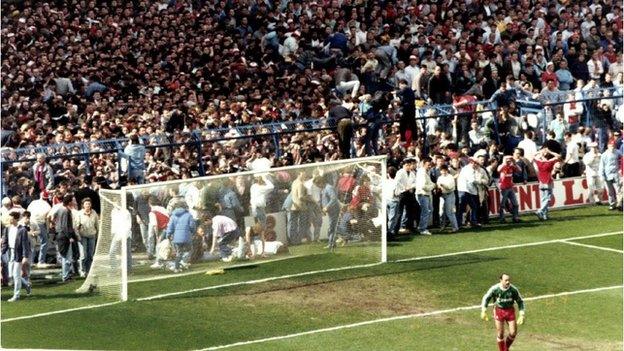
Ninety-six Liverpool fans died following overcrowding at the FA Cup semi-final on 15 April 1989
The new inquests into the deaths of 96 football fans in the Hillsborough disaster started exactly a year ago today. Here BBC reporter Ben Schofield, who has been following the proceedings, summarises some of the evidence heard so far.
A jury of seven women and three men has spent the last 12 months listening to evidence in a purpose-built courtroom in Warrington, Cheshire.
Since the inquests began on 31 March 2014, more than 280 witnesses - including former Liverpool manager Kenny Dalglish, the last to be called in 2014 - have given evidence.
The inquests began with a series of emotional statements about the 96 Liverpool supporters who died following the disaster on 15 April 1989.
Many family members who read them shed tears in the witness box as they recalled memories of their loved ones.
Since then, the evidence about the disaster has been broken down into sections.

Stadium safety and design

Fans were contained in pens and separated from the pitch by steel fences
The fans who were fatally injured at Hillsborough were standing inside the central pens - numbered three and four - behind the goal at the Leppings Lane end of the ground.
In June, the inquests' expert structural engineer, John Cutlack, said the number of fans inside pen three was more than twice its safe capacity.
That pen nominally had a capacity of 1,200 in 1989, but Mr Cutlack said it could only safely hold 678. He calculated that figure based on the layout and height of crush barriers, as well as other design features of the terrace, including its gradient.
Mr Cutlack estimated there were up to 1,430 spectators inside pen three at 3.03pm that day.
About 10 minutes earlier, at 2.52pm, there were 678 fans inside, according to an estimate by the Health and Safety Executive, which coincidentally matched Mr Cutlack's safe capacity figure.
Mr Cutlack also said that pen four, which had an informal capacity of 1,000 in 1989, could only safely hold 778 fans.
The stadium had a safety certificate from 1979. It was regularly inspected by officials from bodies including South Yorkshire Police, South Yorkshire County and Sheffield City Councils, and South Yorkshire County Fire Service, as well as by the club's consultant structural engineer Dr Wilfred Eastwood.
Mr Cutlack said the inspection regime of the ground throughout the 1980s had presented opportunities to reassess the pens' capacity, which were missed.
During this section, the jury also looked back on the 1981 FA Cup semi-final at Hillsborough between Wolverhampton Wanderers and Tottenham Hotspur.
Spurs fans were allocated the Leppings Lane end of the stadium and stood on the terraces which, at that time, had not been split into the 'pens' which were present in 1989.
During the 1981 match, fans on Leppings Lane were crushed - 38 supporters suffered injuries including two broken arms, a broken leg and cuts which required stitches.

Insp Calvert proposed individual turnstiles leading to each of the enclosures
The jury heard that Insp Clive Calvert, who was one of South Yorkshire Police's football liaison officers in the 1980s, had sketched out a plan to redesign the turnstiles at the Leppings Lane end of the ground.
In a statement dated 19 May 1989, he wrote: "In 1984, I and other officers realised that, after Sheffield Wednesday returned to Division One, problems were evident at Leppings Lane turnstiles due to an increase in away fans.
"I suggested with a rough sketch that the whole of the Leppings Lane turnstiles - then a crescent shape - should be demolished with new ones built parallel and near the rear of the stand, with access to individual pens and to the stands," he said.
Mr Calvert said Sheffield Wednesday's secretary, Richard Chester, saw the plans and "came forward with a compromise".
The jury heard that the club built two new crescent-shaped banks of turnstiles at the Leppings Lane end in 1985.
Insp Calvert also raised concerns with the head of 'F' Division, Ch Supt Brian Mole, about the Leppings Lane approach to the ground in 1986.
In June that year, he wrote in a memo: "One of the greatest problems we have is access to the ground, particularly at the Leppings Lane end.
"The redesigned turnstiles do not give anything like the access to the ground, either on the Leppings Lane terraces or in the West Stand, needed by away fans.
"On occasions last season when large numbers attended, we had supporters who were justifiably irate because of the inefficiency of the system, which was turned on the police and could have resulted in public disorder."
On the day of the disaster, more than 24,200 Liverpool fans were expected to enter the ground through 23 turnstiles, while 29,800 Nottingham Forest supporters were able to use 60 turnstiles at the opposite end of the stadium.
The jury heard that in June, 1989, Dr Eastwood wrote that his view was that the disaster "would probably have been avoided" if the police had not insisted all the Liverpool fans accessed the ground via Leppings Lane. Police witnesses have said that decision was taken to keep the two sets of fans segregated.

Planning and preparations
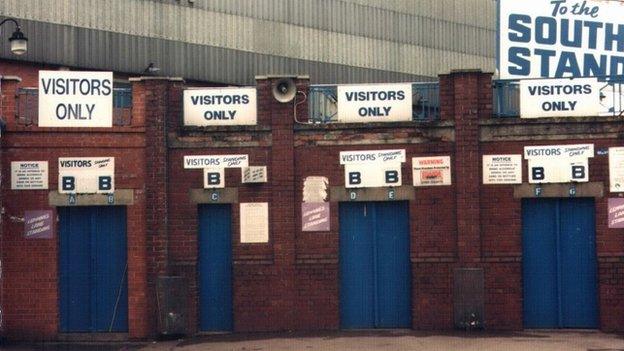
A plan to redesign the turnstiles at the Leppings Lane end was discussed five years before the disaster
Ch Insp David Beal, one of the officers who wrote the police's Operational Order for the match, also gave evidence.
He said he accepted there should have been "contingency" in the orders to cater for a build-up of fans outside the ground.
He said a tactic of police blocking off the tunnel leading into the central pens should also have been included in the order.
Mr Beal added that if he was writing the orders again, he would have posted a dedicated group of officers there to do that.
The year before the disaster, Liverpool and Nottingham Forest had met at Hillsborough in a carbon copy of the FA Cup semi-final tie.
Police officers and fans who were there for that 1988 match have described how filter cordons were in place along Leppings Lane, although the jury has heard CCTV footage shows traffic moving along the road.
Fans have also described being turned away from the central pens by police officers who were blocking the tunnel.
The jury heard that neither the cordons nor the tactic of blocking the tunnel had been in the official 1988 match orders.
Chief Metropolitan Ambulance Officer Albert Don Page said two of his ambulance personnel sat in two seats in the South Stand during league matches at Hillsborough. They were to be the "eyes and ears" of the ambulance control room during games.
But Mr Page said that Sheffield Wednesday sold the tickets for those seats ahead of the FA Cup semi-final. Four ambulance officers were stationed at pitch level in one corner of the ground for the match.

Events of the day: Fans' experiences
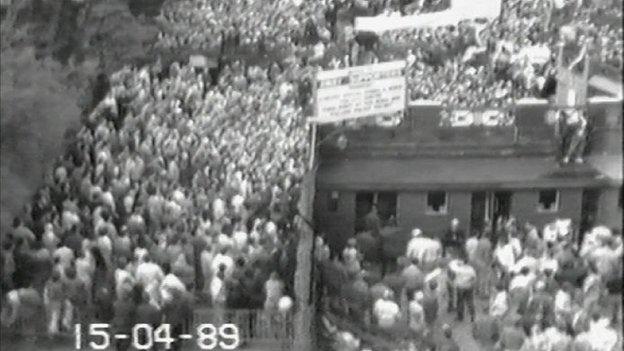
Graham McKay was in charge of crime prevention and detection at Hillsborough
Valerie Yates described struggling for breath, external and then losing consciousness inside pen four.
She said she slipped below the crowd and had a near-death experience. She was pulled up by her hair "like a rag doll".
After waking up on the pitch, gasping for breath, she helped to carry another injured fan on an advertising hoarding.
Philip Duggan, who was 17 at the time and stood inside pen three, agreed that he was, "without a doubt", lucky not to have been the 97th victim.
He said the crowd was packed "almost solid" and that his feet were "rarely" on the ground.
Mr Duggan said there had been a "carnival atmosphere" on the terraces, but slowly it became "tighter and tighter" inside the pen and supporters began screaming in distress.
Alison Willis told the jury that after she escaped from pen four a police officer said she should "get back in".
During Mrs Willis' evidence Sam Green, a barrister who represents the Police Federation, asked: "But was it obvious to you that many of the police officers on the ground, for whatever reason, wholly failed to appreciate that what was unfolding before them was a fatal disaster and that they thought, they were stuck with the mind-set, that what they were dealing with was a crowd behaviour issue?"
Mrs Willis replied that officers "could see exactly what I could see".

Events of the day: Police accounts

Footage of Roger Marshall at the Leppings Lane end turnstiles was shown as part of his evidence
A former inspector, Stephen Ellis, described how fans outside the Leppings Lane turnstiles were "frantic" to get inside the ground.
He described the "mania" and "madness" of the crowd there but denied he was "pushing" the South Yorkshire Police "line" at the inquests.
Many police officers and some local residents described how fans had been drinking and carrying large volumes of alcohol before the match.
Barristers representing the families of those who died have challenged this.
The police superintendent who was in charge of the Liverpool fans outside the ground admitted that his officers "lost control completely" after 2.30pm, but also said that "control was taken from us - it was lost, but it was taken from us".
Supt Roger Marshall said police were "overwhelmed" on the day and said he was doing his "absolute utmost and very best to manage an increasingly deteriorating situation".
Mr Marshall said "one of my most profound regrets" from the day was not asking for the kick-off to be delayed.
He was the superintendent who called for exit gates at that end of Hillsborough to be opened to allow the fans gathered outside into the ground.
Engineer Mr Cutlack estimated that more than 2,000 fans went in through exit gate C after it was opened at 2.52pm for five minutes. The gates were opposite the entrance to the tunnel leading into the central pens. Many of those fans, the court heard, went into those pens.


Another regret, Mr Marshall added, was not calling for a "reception committee" to greet fans as they went through Gate C.
He also said he wanted to "associate" himself with the apologies that had been made by South Yorkshire chief constables for the way the police operation was conducted on the day.
The overall match commander, former Chief Supt David Duckenfield, made a series of apologies while in the witness box and said that he regretted some of the decisions he made on the day.
He was promoted to chief supt on 27 March, 1989. His new position as head of 'F' Division at Hammerton Road also made him "match commander" at Hillsborough, including for the FA Cup semi-final three weeks later.
Mr Duckenfield said that "with hindsight" it was a "serious mistake" for him to accept the role of match commander. He said he had limited experience of football policing, but had received "assurances" that the team around him was experienced.
Conflicting explanations were given for his predecessor Chief Supt Brian Mole's move to a post in Barnsley; some witnesses have said it was for "career development", another said it was fallout over how he handled a prank by officers on a new recruit.
Mr Duckenfield told the jury failing to foresee the consequences of ordering exit gates to be opened at the Leppings Lane end is "arguably one of the biggest regrets of my life". It was a "grave mistake", he added, for which he apologised "profusely".
He accepted that failing to close the tunnel leading into the central pens was a "blunder of the first magnitude" and that it was "the direct cause of the deaths of 96 persons".
The commander also apologised to the families for lying about what had happened. He admitted telling the FA chief executive, Graham Kelly, that fans had forced their way into the ground, but omitted to tell him that he had ordered the gates to be opened.
He said he would regret the omission "to my dying day". He added that he had said something "rather hurriedly" and "without thinking of the consequences and the trauma".
The jury heard how police interviewed Mr Duckenfield under criminal caution in March, 2014. They told him he was being investigated for "serious criminal offences".
A former sergeant who worked with Mr Duckenfield in the police control box that day said he "did not step up to the plate".
Mr Bichard also agreed with one of the families' barristers that Mr Duckenfield was a "fish out of water".
Mr Duckenfield told the court that on the day he was doing his "best" and that ahead of the match he was "confident" he could do the job.
He added that at the FA Cup semi-final he was "new and inexperienced", working to "flawed" police plans, under "intense pressure" and in "unimaginably difficult and fast-moving circumstances".
According to a log written by former PC Trevor Bichard just after the disaster, at 2.55pm he overheard two unidentified officers at the back of the West Stand talking on their police radios about closing the gates across the tunnel leading into the central pens.
When he was questioned about this in court, Mr Bichard said he had forgotten making that entry in his log and said he may have been referring to a different set of gates, not those at the tunnel.
Most of the police officers who have given evidence have described poor radio communications that day.
Former Supt Roger Greenwood, who was in charge of policing inside the stadium, ran on to the pitch at about 3.05pm to stop the match.
He became emotional while recalling the events of the day.
He said when he first saw what was happening on the terraces he thought the situation was "recoverable".
During questioning by his own barrister, Mr Greenwood said he and other officers were doing "their best", but he admitted that on the day his best was not good enough.
Minutes from a South Yorkshire Police Federation meeting held four days after the disaster recorded the Chief Constable Peter Wright saying that if anyone was to blame it was "drunken ticketless" fans.
A football policing expert has said a "perfect storm of events" led to the disaster.

Emergency response
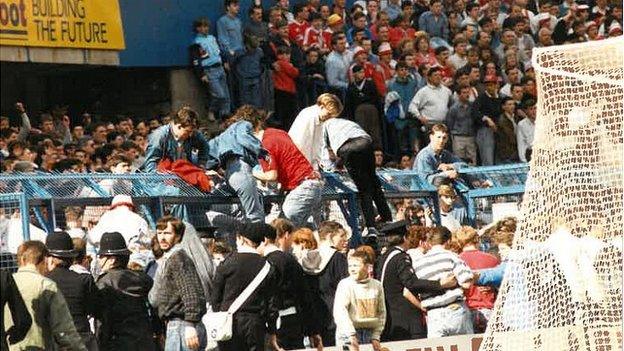
Philip Saxton said he "had to scramble across people's heads and shoulders" to get to the injured
Some witnesses - including the then Liverpool manager Kenny Dalglish - described the "chaos" and "mayhem" in the disaster's aftermath.
Philip Saxton was at the match with St John Ambulance. He described how he watched fans at the front of the pens deteriorating in the crush.
The jury watched footage of him jumping into pen three at 3.12pm, after which he tried to give first aid to casualties he could reach.
The Queen awarded him the British Empire Medal in 1990 for his work that day.
Four SYMAS officers were stationed inside the ground for the FA Cup semi-final. Three of them have given evidence.
Station Officer Paul Eason and qualified ambulanceman Stephen Chippendale were the first from SYMAS to walk to the Leppings Lane end after the 3pm kick-off.
They walked between the pens and the goal, but said they did not notice fans being crushed against the fence at the front.
The first casualty they treated that day had a suspected broken leg.
Mr Eason, whose radio was not working correctly, declared a major incident at 3.22pm after helping to treat one of the fans who died.
Albert Page, who was SYMAS' chief ambulance officer, accepted that Mr Eason took "too long" to make that declaration and that he "had not done an adequate initial assessment".
James Wardrope, a consultant working at Sheffield's Northern General Hospital, said that he and his colleagues could have prepared better if they had been told about a "major incident" sooner.
"Four or five" casualties in cardiac arrest were sent to a temporary mortuary at the hospital because of the sheer numbers of emergency admissions.

Evidence gathering
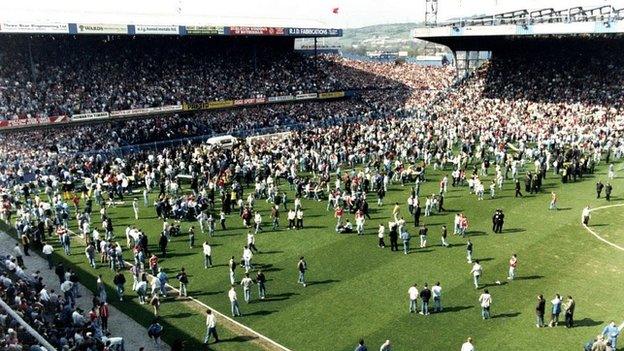
Ninety-six fans died as a result of a crush at the 1989 FA Cup semi-final
The jury has also been hearing about how South Yorkshire Police gathered evidence from their own officers after the disaster.
Officers described how they were told not to write in their police pocket notebooks after the disaster and instead to write up their recollections on plain pieces of paper.
Former Det Supt Graham McKay, who was the first senior investigating officer into the disaster, ordered his officers not to make notes in their pocket books.
He told the jury there was "nothing sinister" in his order and that he believed they needed a "separate document" to record their memories.
The jury has also seen how officers' statements were sent to a solicitor acting for South Yorkshire Police, who suggested changes.
Peter Metcalf, a partner at Hammond Suddards law firm, was one solicitor who read their recollections and reported back to senior officers in the force.
Many of the changes he suggested were incorporated into the statements, which were eventually sent to a team inside West Midlands Police that was supporting the public inquiry into the disaster.
Barristers for the Hillsborough families have said some statements were "sanitised" to remove criticism of the police.
The jury has heard that criticism of fans was sometimes also removed from statements.
Former Deputy Chief Constable Peter Hayes, who led the force's preparations for the Taylor Inquiry, said he understood that "speculation and comment" was being removed from statements and he would have "objected" to anything else being taken out.
Some police officers said they knew their statements were being amended, but others have said they did not.
The jury has also heard from officers who threatened not to sign their statements after they had been changed.
Former Inspector Clive Davis told the jury how he recalled Ch Supt Terry Wain telling a meeting that he was putting a team together and "we were going to put the blame for this disaster where it belongs: on the drunken, ticketless Liverpool fans".
No minutes have been found from the meeting and Ch Supt Wain disputes Mr Davis' account.
Some witnesses were asked about a front page story in The Sun newspaper headlined "The Truth", which was printed on April 19, 1989.
Insp Gordon Sykes said he "regrets" sharing unfounded claims about Liverpool fans pickpocketing the dead.
Mr Sykes accepted that the claims, which formed part of The Sun's story, were false, though he said he never spoke to a reporter.
He said he shared two allegations, which he "honestly believed", with colleagues in the Police Federation.
Mr Sykes said another part of the article did reflect one of his own experiences that day.
The Sun reported fans had jeered at a police officer as he tried to give a female fan first aid.
Former South Yorkshire Police Federation secretary Paul Middup, who was quoted in the article, denied being the chief constable's "mouthpiece".
The inquests may continue until early 2016.
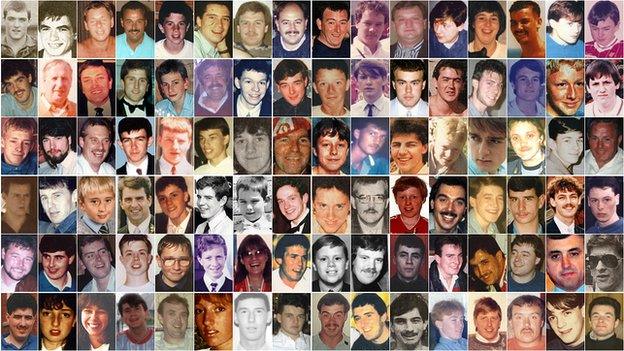
Ninety-six Liverpool fans died in the 1989 disaster